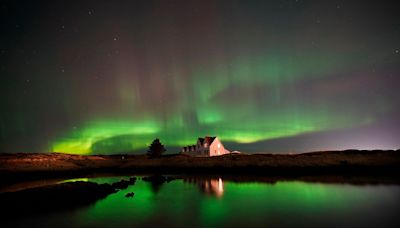Search results
An aurora (pl. aurorae or auroras), also commonly known as the northern lights (aurora borealis) or southern lights (aurora australis), is a natural light display in Earth's sky, predominantly seen in high-latitude regions (around the Arctic and Antarctic). Auroras display dynamic patterns of brilliant lights that appear as curtains, rays ...
Aurora. The Aurora Borealis (Northern Lights) and Aurora Australis (Southern Lights) are the result of electrons colliding with the upper reaches of Earth’s atmosphere. (Protons cause faint and diffuse aurora, usually not easily visible to the human eye.)
The two maps show the aurora and viewline tonight and tomorrow night. The brightness and location of the aurora is typically shown as a green oval centered on Earth’s magnetic pole. The green ovals turn red when the aurora is forecasted to be more intense.
May 10, 2024 · Eric Lagatta. USA TODAY. 0:04. 0:36. Read the latest on the northern lights this weekend: Saturday's forecast says parts of U.S. could see auroras. A series of strong solar flares that the sun...
Jun 10, 2021 · How the aurora form. The sun is volatile, and violent events there such as geomagnetic storms can echo out into the universe. In some cases, the sun's disturbances are so strong that they yank on...
Oct 19, 2023 · In the north, the display is called aurora borealis, or northern lights. In the south, it is called aurora australis, or southern lights. Auroras and the Solar Wind. The activity that creates auroras begins on the sun. The sun is a ball of superhot gases made of electrically charged particles called ions.
Mar 4, 2024 · The Northern Lights are a stunning display of glowing, swirling lights in the night sky that have amazed humankind for thousands of years. But what causes them? And how can you see them?

